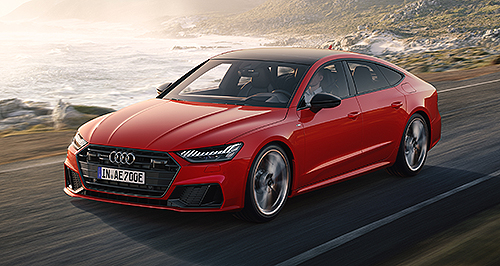Make / Model Search
Future models - Audi - A7 - 55 TFSI eFrankfurt show: Audi includes quattro in plug-in A7Plug-in hybrid A7 55 E Quattro becomes Audi’s top-shelf PHEV11 Sep 2019 AUDI became the first European luxury car-maker to launch an all-wheel-drive plug-in hybrid large car when it unveiled its new PHEV flagship, the A7 Sportback 55 TFSI E quattro, at this week’s Frankfurt motor show.
While rivals such as Mercedes-Benz and BMW have rear-wheel-drive PHEVS such as the E350e and 530e, Audi has gone the whole hog by including its familiar quattro drive system in its first attempt at a big PHEV luxury car based on the recently released A7 coupe-style sedan.
The Audi PHEV is powered by a 185kW/370Nm 2.0-litre petrol engine with assistance from a 105kW/350Nm electric motor incorporated in the seven-speed automatic transmission.
Combined, the engine and motor produce 270kW of power and 500Nm of torque which is sufficient for a 0-100km/h dash in 5.7 seconds. Top speed is constrained to 250km/h.
The A7 can drive at up to 135km/h on the electric motor alone before the petrol engine kicks in.
Electricity from the 14.1kWh lithium-ion battery mounted under the boot will propel the A7 electrically for 40km under normal driving, contributing to an official combined fuel consumption reading of 2.1 to 1.9 litres per 100km.
Recharging from a high-power charger can be accomplished in 2.5 hours, while home charging on a 240-volt socket takes seven hours.
The driver can select from three driving modes – EV, Battery Hold and Hybrid. EV is the default setting under which the car can be driven in full-electric mode until the battery runs out, unless the driver sticks the boot into the accelerator to ignite the petrol engine.
Battery Hold mode switches the car to petrol power so that a reserve of electricity can be retained in the battery for later use.
The Hybrid Mode can employ the sat-nav system to pick between petrol and electricity for the greatest overall efficiency on a trip.
As well, the A7 55 TFSI E uses Audi’s predictive drive management to make sure that the battery is full in highway driving so that the last bit of the journey in an urban area is done on battery alone. This is particularly important in some European cities that demand emissions-free driving in some urban areas.
Regenerative braking via the front wheels and electric motor/generator take care of all but severe stops, pumping up to 85kW of electricity into the battery at 0.2g.
The driver gets a tap in the foot from the haptic accelerator pedal when the car changes from petrol to EV and back again. The car also coaches the driver via various signals to encourage more efficient driving.
The climate control system can pre-condition the car’s cabin via controls on the My Audi phone app to save battery energy once the journey starts. This even applies to the seat and steering-wheel heaters.
The app can also be used to check the battery and range status, start the charging process, program the charge timer and view the charge and consumption statistics.
The PHEV A7 will hit the showrooms of Europe later this year, but it remains to be seen if Audi Australia will take it, as numbers are likely to be small.
If they do, the car will have the BMW 530e ($112,900 plus on-road costs) and Mercedes-Benz E350e ($135,400) to contend with.
The recently launched petrol-only Audi A7 55 TSFI quattro with a 3.0-litre V6 sells for $131,542.  Read moreAll future modelsA7 pricing
Motor industry news |
Click to shareAudi modelsResearch Audi All future modelsA7 pricing
Motor industry news |


 Alfa Romeo
Alfa Romeo Abarth
Abarth Audi
Audi Aston Martin
Aston Martin BMW
BMW Bentley
Bentley Ferrari
Ferrari Chevrolet
Chevrolet Ford
Ford Fiat
Fiat GWM
GWM Foton
Foton Hyundai
Hyundai Honda
Honda Jaguar
Jaguar Isuzu
Isuzu Kia
Kia Jeep
Jeep Land Rover
Land Rover Lamborghini
Lamborghini Maserati
Maserati Lexus
Lexus McLaren
McLaren Mazda
Mazda Mercedes-Benz
Mercedes-Benz Mitsubishi
Mitsubishi Mini
Mini Peugeot
Peugeot Nissan
Nissan Ram
Ram Porsche
Porsche Rolls-Royce
Rolls-Royce Smart
Smart Skoda
Skoda Suzuki
Suzuki Subaru
Subaru Toyota
Toyota Tesla
Tesla Volvo
Volvo Zeekr
Zeekr







Facebook Twitter Instagram